
You can find my AAR of Apocalypse here.
Apocalypse, the first successful British computer wargame, is not computer-native but the port of a board game released only three years earlier by Games Workshop. I have been dancing around Games Workshop for a while as I covered Red Shift and its successor the SLUG cooperative, and I feel it is time to give a little more detail on the beginnings of the tabletop game company that probably had the most impact on computer gaming.
Games Workshop was founded in 1975 in London by three gamer school friends: Ian Livingstone, John Peake and Steve Jackson (a different one than the Steve Jackson of Metagaming Concepts). All of them had jobs, so Games Workshop was seen as fun side gig that could one day be profitable. The new company was doing exactly what its name implied, in the most literal sense possible: handcraft traditional games. Its catalogue in March 1975 included Backgammon, Mancala, Nine Men’s Morries, Paronama, Go, Solitaire and Tower of Hanoi. Peake was the craftsman, Livingston the salesman and as for Jackson, well, he was managing anything that needed managing.

To get their business going, Jackson published starting in February 1975 a newsletter called the Owl and Weasel. Of course, the trio had no customers to send newsletters to, but Livingstone had significantly contributed to Albion, a magazine created in 1969 by Don Turnbull as a DipZine (fanzine on Diplomacy) which had pivoted to wargames over time and had sent its last issue in January 1975. Livingstone, or possibly Jackson, asked Turnbull whether he could use Albion‘s mailing list, Turnbull accepted, and just like that the Owl and Weasel had a readership. A readership that did not know that the Owl and Weasel even existed, but that would have to do for now. The first issue of the Owl and Weasel was short (it occupied both sides of one A4 sheet) and included a call for contributions: “we’d especially like to hear from anyone who is concerned with what could be considered as “progressive games”, in which I would include Hyboria and Midgard, computer gaming, psychological games, new ideas about abstract games, and so forth.“
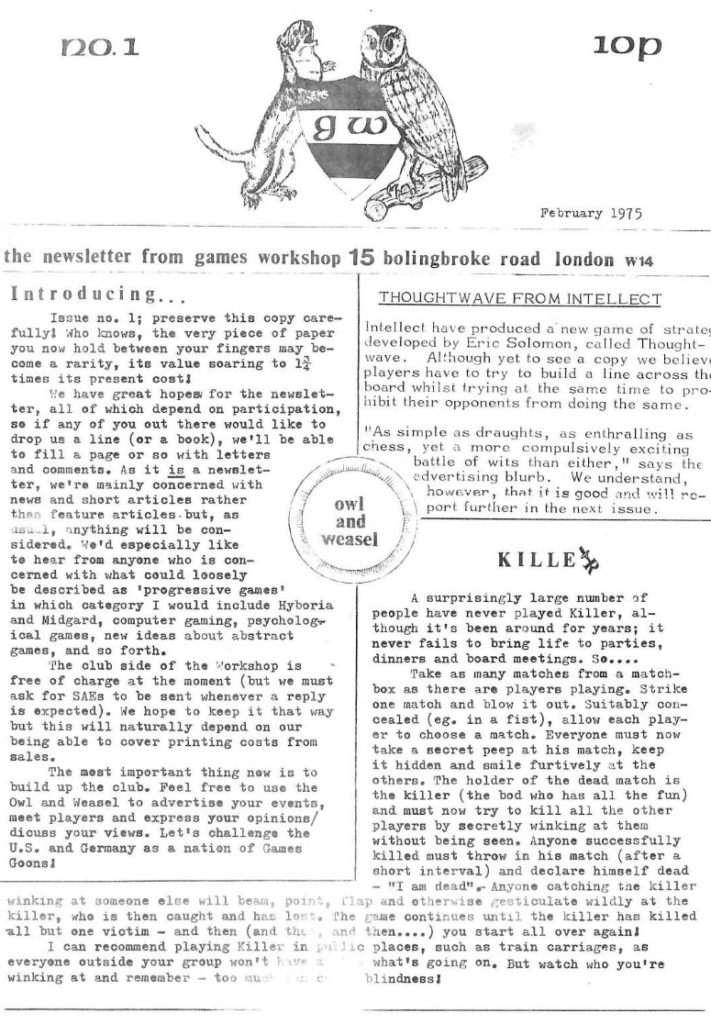
Six years earlier, Turnbull had used a similar trick to launch Albion, which he disseminated by using the mailing list of the Avalon Hill International Kriegspiel Society. This gave Albion – and by inheritance the Owl and Weasel – an unexpectedly large American readership for a British amateur publication. “Large American readership”, in this case, is to be taken relatively: the first issue of the Owl & Weasel was only sent to 50 addresses. Nonetheless, its peculiar request for “progressive games” reached Brian Blume, one of the three owners of a new Wisconsin firm called Tactical Studies Rules (TSR). Blume handed the newsletter to co-founder Gary Gygax, and Gygax wrote back to Games Workshop that he had a game that could fit such a description: Dungeons & Dragons (D&D) – test version attached. By coincidence, Livingstone and Jackson had seen the game at the Citicon convention earlier in May 1975, but were unable to play or order it directly from the US as was the only option then – still, they had made a note of it in the 5th issue of their newsletter.

When Jackson and Livingstone could finally test Dungeons & Dragons, they realized it was everything they had been looking for. They ordered 6 copies of D&D – all they could afford – advertised them in the July issue of the Owl and Weasel, and sold them immediately. They returned to TSR, ordered more copies, and then yet more copies. TSR understood it had found some European evangelists and in late 1975 it gave for 3 years exclusive rights to sell D&D products in the UK to Games Workshop. Livingstone and Jackson took heart in their new role and D&D took a growing share of the Owl & Weasel and more generally Games Workshop’s revenue; Peake on the other hand was only interested in traditional games and left Games Workshop in January 1976.
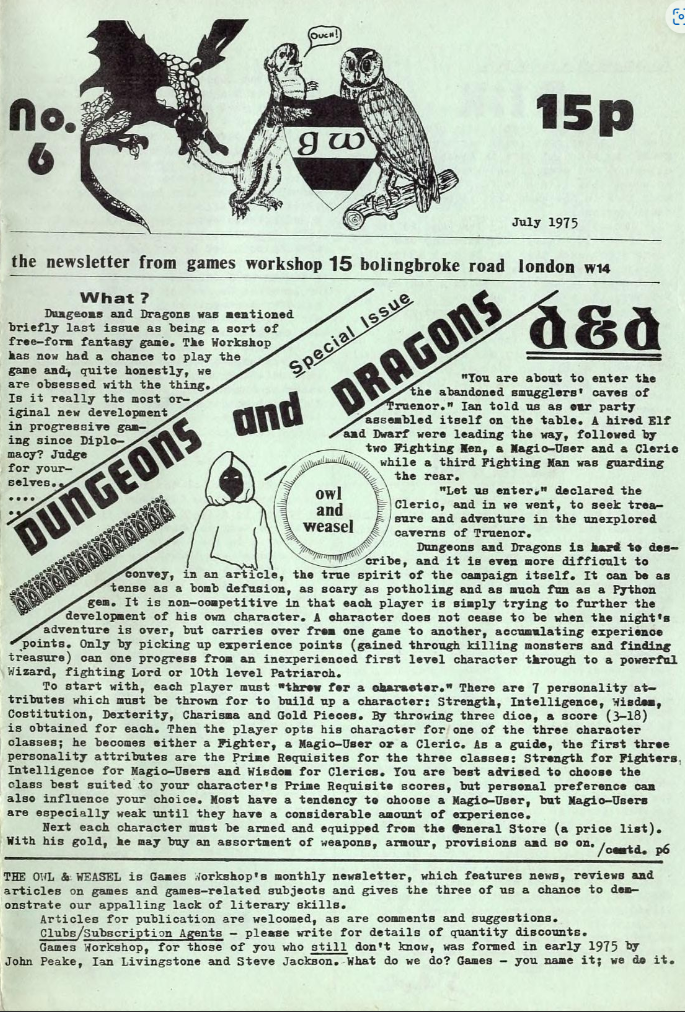
I am a bit puzzled at the “Gold Pieces” personality attribute.
For Games Workshop, 1976 was the year of a growing disconnection between the company sales – booming – and its operating resources – minimal. Its office was Livingstone’s girlfriend’s house, its newsletter/magazine looked like a fanzine and critically it had no brick-and-mortar shop to store their increasing inventory, particularly after the duo visited Gen Con IX in 1976 and added several American publishers to their catalogue. The key problem for Jackson and Livingston was the lack of capital: they could not find a bank willing to invest in something as frivolous (and low-margin) as games, so all their financing had to come from their cash flow. This changed in 1977-1978 with three decisions. First, Owl & Weasel was replaced by the professionally looking White Dwarf that could be distributed anywhere and not just in hobbyists’ shops (the first issue, in June 1977, had two reprints and sold 6000 copies in total). Second, Games Workshop opened its first shop on April 1st, 1978 in Hammersmith, with more than one hundred people lining up in front of the doors that morning. But the most momentous decision had come a bit earlier, in late 1977. Jackson and Livingston had realized that it would be cheaper to produce their wares locally rather than import them, and so they started printing the American games in the United Kingdom.

With the store, the magazine, the production know-how and the prestige, Games Workshop became the go-to firm for any American company looking to penetrate the British market. They signed deals with most American game publishers, though D&D remained their flagship product. It is also in that era (December 1978) that Jackson, Livingstone and the sculptor Bryan Ansell founded Citadel Miniatures, which would become pivotal to Games Workshop down the line – but that’s out of the scope of this article.
Since it had an independent production capacity, Games Workshop also started to publish original products. Initially, it was limited to a few D&D gaming aids (character sheets, floor plans, …), then it became more ambitious with the Fiend Folio, an additional monster manual recognized as official D&D material by TSR and penned by a returning Turnbull. But of course, the D&D exclusive was running its course, and Games Workshop knew it would have to fly with its own games. There would be four board games, all released together in 1980: Doctor Who, Valley of the Four Winds, Warlock and finally Apocalypse.
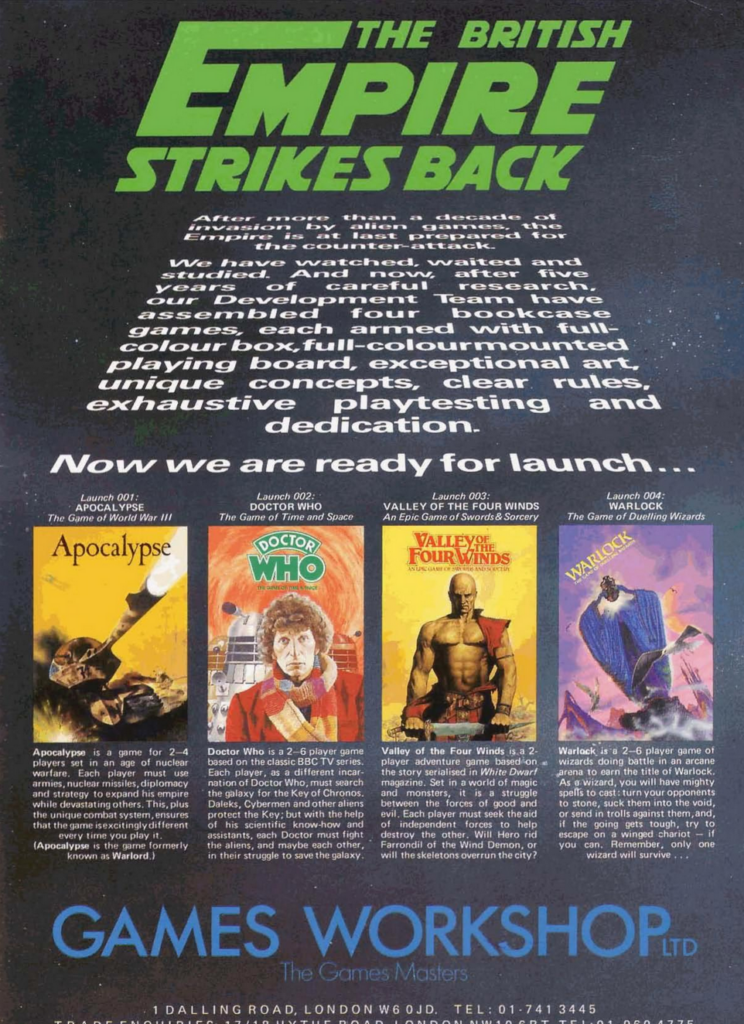
The Best Game of All Time
Back when he was a student, Steve Jackson had founded the University of Keele Game Society. The early months of the Society were spent playing games that wouldn’t pass the snooze test anymore, the likes of Monopoly, Risk or Formula 1. Eventually, Jackson was introduced to Diplomacy. This was an immediate hit in the club, and Jackson was trying to convince everyone he knew to come and play it, or at least he did until he crossed the path of some fellow student called John Parker, the cool dude of his promotion. As Jackson remembered, “whatever you told him, he knew something better“, but this time Diplomacy would be hard to beat, wouldn’t it? And yet, Parker had an answer to Diplomacy: “You should play The War Game, now that’s a great game.“
“The War Game” turned out to be Mike Hayes’s The Warlord. Parker had misremembered the name, but for the rest Jackson agreed he was spot on: The Warlord was better than anything else he had played before, Diplomacy included. His club concurred and soon The Warlord replaced Diplomacy as the go-to game for night sessions. Jackson still calls it the best game of all time.

Reading the rules now, it is easy to understand what made it different in the early 1970s. The Warlord features a map of Europe & North Africa, divided into provinces on which any number of armies can stack – a bit like Risk. Unlike Risk however, attacks are not resolved by throwing dice. Instead, the dice are used in combat for a little bluffing game. Both sides secretly choose a value on their die (it can’t exceed the armies available for attack for the attacker); if the defender’s die matches the one of the attacker, then the attacker loses as many armies as the value of the dice. Else, the defender loses one army – and only one. The attacker, of course, can repeat their attack or attack somewhere else.

Against large stacks of defenders, the game had another option: A-bombs. Every time an attacker won a battle, he would receive an A-bomb counter that could be put on any province. Adding a counter to an existing bomb would increase its range in terms of provinces (up to a maximum of 4 in the first edition, unlimited in the later ones). When used, bombs would destroy all units in the targeted province and all the neighbouring ones. The targeted province would also be irradiated – unavailable until the end of the game.
Jackson was smitten by the game. Once Games Workshop had been set up, he contacted Hayes to distribute his game through the Owl and Weasel. Hayes accepted, but only a few copies were sold. Probably disappointed, Jackson penned a two-page article on The Warlord, starting with”Ten years is a long time for a classic game to go unnoticed. It happened though to The Warlord”. Jackson’s unpaid ad may have triggered a regain of interest in the game, because Hayes released a second edition of The Warlord (called just “Warlord“) in 1979 with some significant changes (particularly the addition of H bombs and sea tiles, the latter replacing port-to-port movements à la Risk). When Games Workshop decided to publish its own board games, Jackson naturally contacted Hayes. In his White Dwarf article, Jackson had found two flaws in the Best Game of All Time: it was pricey (around £10) and it was too long to play. The Games Workshop edition, renamed Apocalypse, solved those issues by halving the size of the map, which made the game cheaper (around £7) and faster to play. The ruleset was a mix between the first and the second edition, which Jackson liked less: it had sea zones, but no H bombs.
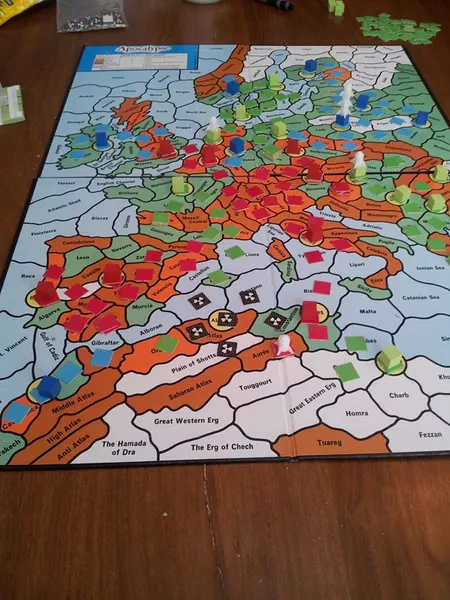
Livingstone states in his memoir that the first batch of board games to be a success, selling around 5000 boxes each, but to my knowledge none of them received expansion nor a second edition – Apocalypse did not for sure.
Red Shift’s Apocalypse
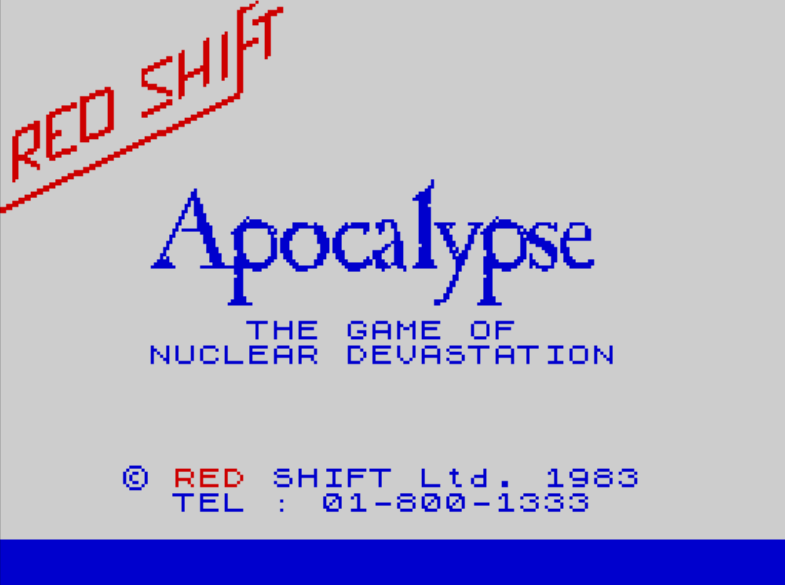
The story now ties back to my first article on Red Shift. After co-founding Red Shift, Helmut Watson visited Ian Livingstone to show him one of his board games, hoping to get published. Livingstone was presumably not impressed by the board game, but he saw a lot of potential in the young company. Games Workshop was not entirely new to video games – Jackson and Livingstone had a Commodore PET for business operations and an Intellivision for game nights. They had seen, like everyone else in the UK, the boom in demand for video games that followed the launch of the BBC Micro and the Spectrum, and wanted to take their share of the pie. Eventually, just like they had done with figurines and boardgames, Livingstone and Jackson reckoned they could publish their own games based on their licences – Watson had arrived at the perfect moment.
For unknown reasons, the computer version of Apocalypse was significantly different from the boardgame; I suppose Watson and his associate Julian Fuller wanted to add their personal touch. The most glaring difference is that nuclear missiles are bought, not earned after a successful attack. This “realistic” change badly hurt the game: you can’t use the nukes the turn you build them, and since your opponents can build armies wherever they want and move them by 6 squares by turn, the nukes are easy to capture – particularly because while you are building nukes you are not building armies. In our game, around half the nukes launched were not launched by their original builder, and I suspect that between veteran players they are only used in niche cases, for instance when you betray your allies.

The other changes include a different economic system generating a higher unit count (to the detriment of the game, given how slow it is), combats that can destroy more than one defending unit (also a negative, as I will explain later), dedicated naval units and the fact that the nukes do not destroy areas outright. On the plus side, Apocalypse shipped with four maps instead of one: the Spectrum version had Western Europe, Caribbean, Great Britain and London while the BBC Micro had Western Europe, Caribbean, South Africa and Levantine Coast. There are other differences between the Spectrum and the BBC Micro versions: the BBC Micro could accommodate up to 9 players on the same map (Spectrum: 4) but was nigh impossible to read. Both versions were released at roughly the same time in August 1983 and sold for £9.95.

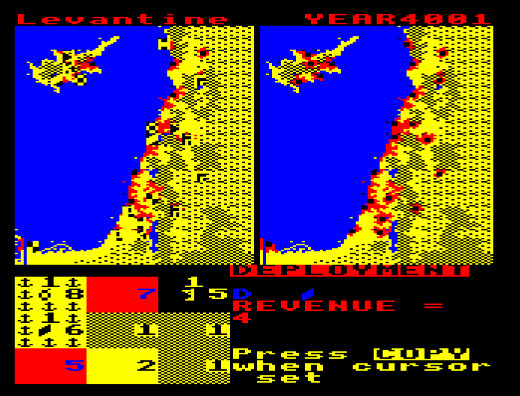
I don’t know how many copies Red Shift’s Apocalypse sold, but it must have been plenty because the Spectrum version received 3 data disks in late 1983, all sold for £4.95. The first data disk (“Volume 1”) adds 6 more maps (USA, South Africa, South-East Asia, Middle Earth, Space and Arctic Circle) but doesn’t change the rules at all.

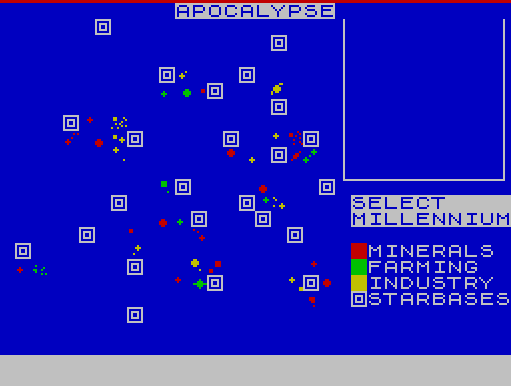
The second and third data disks (“Volume 2 Chapter 1” and “Volume 2 Chapter 2“) are scenarios, with pre-deployed units and changes of rules. The manuals are lost, but they have been reviewed in ZX Computing, so we know what they offered:
- The Rome scenario has no nuclear missiles (obviously), slightly different combat rules and plagues that can devastate troop concentrations:
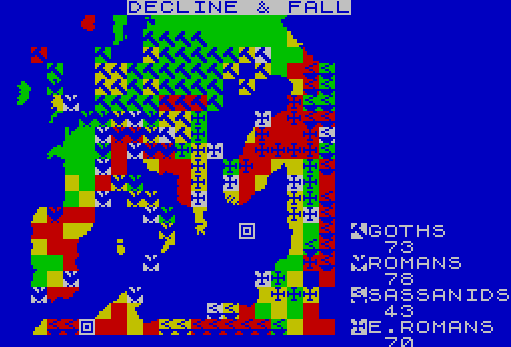
- The Napoleon scenario has no missiles either, a time limit and generals who can be killed or captured,

- The Pacific War scenario introduces air strikes, replacing the nukes. I have not been able to launch it.
- Finally, the 1984 scenario is supposed to have an Apocalypse gauge that fills as NATO and USSR fight, but I have not been able to see said gauge.

We’re done with the history of the game, let’s move to the ratings!
Ratings & Reviews
Apocalypse by Helmut “Woof!” Watson and Julien “Dino” Fuller, first published by Red Shift, UK.
First release: August 1983 on Spectrum and BBC Micro
Genre: Conquest
AAR: Multiplayer AAR or here for the memes and our real-time comments
Average duration of a campaign : Highly varying
Total time played: One PBEM game of 18 turns.
Complexity: Easy (1/5)
Rating: Totally obsolete
Ranking at the time of review: 102/135
A. Presentation: Quite poor. Functional, but not immersive.
B. UI, Clarity of rules and outcomes: Terrible. The rules are poorly explained, the commands are unresponsive (you need to hold the buttons) and yet it is easy to make input mistakes. Worse of all, the game is agonisingly slow. We all cranked up the speed of our emulator by 300% at the very least – it baffles me that people could play Apocalypse at historical speed.
C. Systems: Very poor. You can solve combat with either a bluffing mini-game or by randomisation. Bluffing and the dice reveal is probably fun in the boardgame, but stale when mediated by a computer, particularly as the first player is forced to type their choice while hiding what they are typing on the keyboard. I also can’t imagine the bluffing mini-game to be interesting after say the 8th combat in a given turn. This leaves randomisation and its extreme output.
Another issue with the combat system is that it does not incentivize you to leave more than 1 defender on any tile. Cities can only be attacked with a minimum commitment of 5, so the minimum losses for the defenders is always going to be 5 (the number of defenders has no impact on the losses on the attacker). Even outside of cities, when combats are randomized having 2 or 3 defenders instead of only 1 will seldom make a difference.
Nukes are niche units that should be only used to betray someone or when they can’t be captured, which is rare: your opponent can build armies next to your short-range nukes, and your long-range nukes are going to be so expensive you would be better off buying armies instead (and can still be captured anyway!)
With fast armies that can be built anywhere, a combat system that favours leaving only 1 army by tile and nukes rarely a viable option, winning in Apocalypse is just a question of having a larger economy than your neighbours, with a strong snowballing effect. This is mitigated when there are 3 players or more due to the role of diplomacy, but that’s the same with all games with more than 2 players – not something intrinsic to Apocalypse‘s ruleset. The only exception is the early game, where good prioritisation and better luck can give an advantage.
D. Scenario design & balancing: Very poor. Four maps in the base game, but I can’t give a lot of credit to a game with no AI opponents.
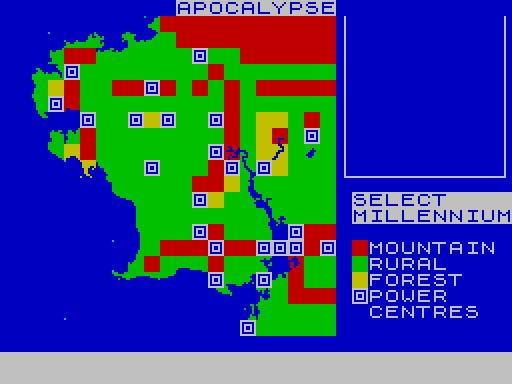
E. Did I make interesting decisions? At the beginning only. After that, most of my interesting decisions were diplomatic. Once I had a stronger economy and a solid alliance, I don’t think opting for one strategy rather than another would have made a difference.
F. Final rating: Totally obsolete. None of us liked it. You can read Dayyalu’s, Operative Lynx’s and KarbonKitty’s assessments of the game on the forum. I reckon a more faithful port of the boardgame would have been better.
Reception
Much to my surprise, Apocalypse‘s reception was excellent – I assume you had to be there to understand how good the game was compared to what was available. The best review probably came from Crash‘s review of Strategy Games by Angus Ryall in October 1984. This review draws a depressing picture of the games available on the British market, as it splits almost all titles between two categories: the dodos, and the diehards (“slightly better, but still terrible”). Two games escape this scathing overview: Apocalypse and Rebelstar Raiders, which are described as Diamonds. I am sure that Angus Ryall also being the Software Marketing Manager for Games Workshop played no role in this rating. Weirdly, Ryall describes Apocalypse as “an anti-war game […] but it’s subtle in its methods – it really works by forcing the players to think about the consequences of aggression” – if Apocalypse is an anti-war game I can confirm it is subtle indeed.
It would be easy for me to discount the praises received by Apocalypse on cronysm, but all the Crash reviewers who had Apocalypse in their hands loved it, starting in the (anonymous) mini-review in the February 1984 issue (“Should keep the addict going for a very long time. Very good value“) and ending in 1987 with a full (re)review at the occasion of a re-release by Command software, in which Phillipa Irving calls Apocalypse a “good buy” if you have someone to play with. Similarly, a reader of Crash states in an August 1986 letter to the editor “I am not knocking Rebelstar Raiders but I feel it comes nowhere near Apocalypse in terms of quality“, to which the “editor” Sean Masterson answers “I do prefer Apocalypse“.
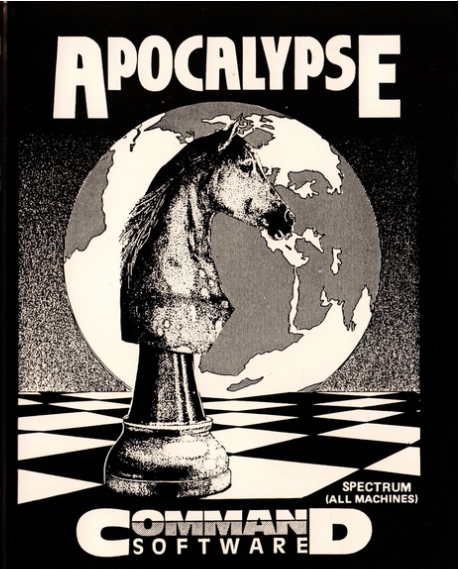
I find similarly positive reviews outside of Crash, and while they almost always mention the sluggish control, they usually qualify the game as “excellent” (ZX Computer Magazine, April 1984) or “addictive” (Micro Adventurer, July 1984). As late as June 1987, Sinclair User describes it as “ugly as Hell”, explains that the movement system can be very tiresome, warns that there is no one-player option, but concludes: “It should be a dodo. But actually it isn’t.” There are a few mediocre reviews (eg Your Spectrum in March 1984), but they are isolated voices.
Apocalypse was what it was, but it was certainly the best multiplayer strategy game in Britain in the early 80s – if that’s what you were looking for, you had to cope with the slow movements and the shallow gameplay. I have spent more time than I expected on this game, but the discrepancy between its importance (it was still used as a reference namedropped in every article mentioning British strategy games until at least 1987) and its quality by modern standards intrigued me. However, I am now happy to return to North America.
Main sources for the history of Games Workshop:
- Designers & Dragons: The 70s,
- Dice Men: The Origin Story of Games Workshop by Ian Livingstone with Steve Jackson
- The Ultimate Interview with Gary Gygax, to take with a massive pinch of salt
- Forty Years of Games Workshop
- Interview of Ian Livingstone and Steve Jackson
- The Owl & Weasel archive
- The White Dwarf archive